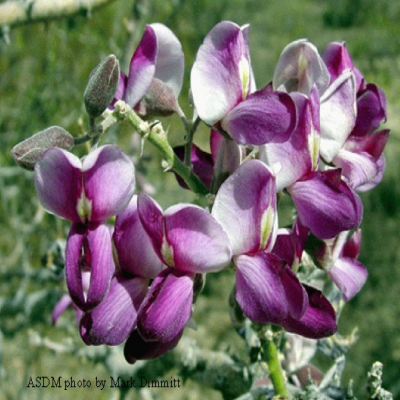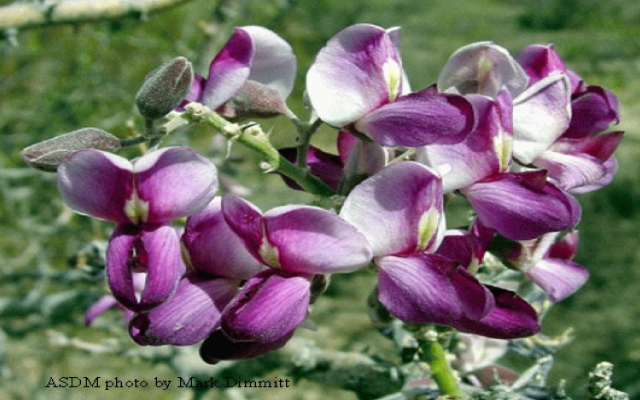
The desert ironwood (Olneya tesota) is a hardy tree that grows up to 35 feet tall. Its leaves hide a pair of sharp, curved spines. According to the Arizona-Sonora Desert Museum, “The nearly evergreen foliage is dense and deep green in wet years, sparser and gray-green during drought. In the extremely arid islands in the central Gulf of California the trees become completely leafless at times. Mature trees also shed their leaves a few weeks before flowering in May, then re-leaf when the summer rains come; only limbs that will flower drop foliage.”
The trees don’t bloom every year, perhaps two out of five. The flowers range from white to deep lavender, often becoming darker with age. The trees bloom for only 10 to 18 days.



The desert ironwood ranges throughout the Sonoran Desert but is restricted to areas where the temperature does not regularly fall below about 20 F. In very dry areas, the trees are restricted to washes.
The desert ironwood produces edible beans that are high in protein and taste like peanuts when cooked. There is, however, a caveat: the beans are mildly toxic and should not be eaten in large quantities without proper preparation. The Seri Indians prepared the beans by twice boiling them and discarding the water in between. The flowers are also edible. Many animals eat the beans without apparent ill effect. See information from Desert Harvesters on harvesting the flowers and beans for food.
Desert ironwood trees grow slowly, but live long, 300 years or more. Age determination is difficult because tree growth rings are incomplete or even missing. The wood is so dense, it will not float in water. The density makes the desert ironwood a favorite of wood carvers.
The wood is essentially non-biodegradable. Dead trees can stand for 1,000 years. They do not rot due to toxic chemicals in the dark heartwood. It may take centuries for dead ironwoods to physically degrade. Some dead ironwoods have been carbon-dated at 1,600 years old.
Ironwood makes excellent firewood which burns long and hot. In the past, the trees were almost extirpated in parts of Sonora from use as firewood and harvesting for carving. Such practice is now illegal; the trees are protected in both Arizona and Sonora.
There are many desert ironwood trees in the Tucson Mountains along Gates Pass and along Kinney Road on the way to the Arizona-Sonora Desert Museum. Also of course, the trees occur in Ironwood Forest National Monument near the Silver Bell Mine between Tucson and Marana. (See that link for many photographs.)
http://youtu.be/FtHiCpYAI3MSee also:
Agaves provide food, fiber and adult beverages
Ocotillo – an aide to hummingbirds and geologists
Chiltepin peppers, spice and medicine
Saguaro Cactus Icon of the Sonoran Desert
Yuccas provide food, fiber, and soap
The Jojoba bush and its valuable oil
Mesquite trees provide food, fuel, medicine, and more
